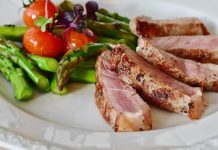Rice is a great pantry grain item and is used in many cuisines. It is also low in fat, low in sodium and gluten-free, making it a quick cooking healthy starch as well.
A typical side dish often seen on dinner tables is steamed or boiled white rice, often long or medium grained. But there are many different varieties of rice ranging in colors from stark white to rich brown and individual long grain rice to sticky clumps of short grain rice. Recipes will often call for a specific type of rice for a certain function in the recipe, such as short grained to absorb large amounts of liquids or long grained to prevent the dish from becoming too sticky.
Table of Contents
Rice is a grain, and the kernel is composed of several layers including the embryo (inner portion of the rice kernel), the endosperm (which covers the embryo), the bran layer (containing nutrients and fiber) and the hull or husk (outer portion). Since the hull is inedible it is removed during processing. Further processing may include removing the bran layer. White rice has the hull and bran layer removed and often polished while brown rice has the bran layer still intact.
Not only is rice a great pantry item, but it is healthy as well. It is sodium-free and cholesterol-free. Rice is also attractive to those who suffer from gluten intolerance since it is gluten-free as well. Rice is low in fat and contains about 100 calories per 1/2 cup serving of plain rice.
There are generally three different types of rice on the market which are broken down by the length of the grains themselves. Short grain rice is roundish in look and produces a sticky and chewy end-result when cooked. Medium grain rice length is roughly about two to three times the width for each kernel. This type of rice is less sticky than short grain but will stick together. Long grain rice length is roughly three to five times the width and the grain cooks up separately.
Here are several different varieties of this healthy grain, with basic water to rice ratios for cooking. Each can generally be found in any local supermarket either in the grain or ethnic sections, or in Asian markets.
Basmati Rice
Basmati Rice is a specific long grain rice and is an excellent white rice to serve cold in salads and in cold dishes. This type of rice can be used in this way since it stays soft even when cold, making it an easy accompaniment to lunch boxes.
It has a unique flavor profile that goes well with any number of cuisines. As it cooks it stays the same width but grows in length, making it pleasing to the eye as well. A general ratio for cooking basmati is 1 1/2 to 2 times the amount of water to rice, more or less depending on the firmness needed for the finished product.
Long Grain White Rice
This refined white rice has a neutral flavor, and cooks up with the kernels being separate rather than sticky. White long grain rice is often polished and is a generic term for most recipes calling for ‘white rice’ since it behaves in a manner that makes it good for side dishes: separated and not sticky. A general ratio for cooking long grain rice is 2 times the amount of water to rice.
Arborio Rice
Arborio rice is a short grain white rice and is used in Italian recipes for making risotto. It cooks up sticky, and when cooked as risotto creates a creamy texture when finished. It has the ability to absorb liquids well making it good for rice puddings and baked dishes.
Arborio rice is often cooked slowly while retaining a certain ‘bite’ to it, al dente, similar to pastas. The amount of liquid when making this short grain rice varies greatly between recipes but a general rule is about 3 times the amount of water to rice.
Jasmine Rice
Jasmine rice is a long grained variety of rice, and is ‘perfumy’ in nature giving a hint of fragrance to a meal. It is a popular rice to serve with ethnic Thai dishes as it originated from Thailand.
It is a popular white rice to serve as a side dish, and pairs well with spicy dishes. A general ratio for jasmine rice differs slightly from regular long grain rice in that it generally calls for less water to cook up nice, about 1 3/4 to 2 times the amount of water to rice. Jasmine rice is best when it is cooked up more firm rather than very soft.
Whole Grain Brown Rice
This type of rice has the bran part of the grain intact along with the germ layer, and is much more nutritious than the more refined white rice types. Since the outer layers have not been removed, this type of rice takes longer to make, is chewier in texture and has a nutty flavor to it. A general ratio is 2 to 2 1/2 times the amount of water to rice, depending on the finished texture of the rice.
Black Sticky Rice
Black stick rice (black Thai rice) can be found in Asian markets. This type of rice actually cooks up with a dark purplish color rather than as a stark midnight black when cooked and is sometimes mixed with white glutinous rice in recipes.
Because of its flavor and texture it is often used in sweet puddings and breakfast dishes, and contains the bran coating requiring a longer cooking time as well. Soaking is often called for in recipes before cooking for a period of time covered in water, then drained and cooked with about 1 to 1 the amount of water to rice. It is also popular served steamed.



